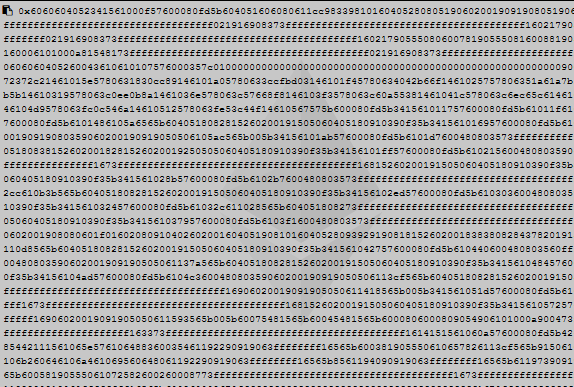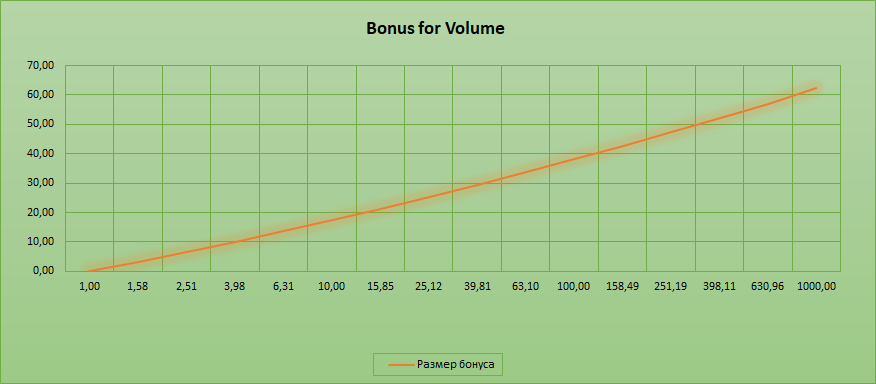Ethereum smart contract for calculating bonuses using fractional degrees

I'll start with what everyone knows. ICOs are everywhere, everyone offers different projects, everyone sells tokens. And everyone has some kind of sales model with discounts, bonuses, terms, etc.
Oddly enough, even though the area is quite experimental, the bonus model is quite primitive. It’s just that there are different volumes or time intervals and percentages in them. And why complicate it? But I still try. An experiment for the sake of. New always attracts.
In addition to the issue of security, the second most important issue when writing a smart contract is the issue of optimization. Each transaction consumes gas, and therefore ether, which is consumed during transaction processing. If the code is complex, requires a lot of calculations, it will be very expensive for investors in the ICO.
Now imagine that we want to make a smooth bonus curve depending on the amount of invested funds. And not just linear, but power-law.
Bonus = (Volume of Invest ^ 0.07) -1
Here is what it looks like on the chart: The

average investor, according to current statistics, invests about 5 ETH, so suppose that if the volume is less than 1 ETH, the bonus will not be awarded.
You will have to calculate using only the uint type, since float is still quite experimental and again quite expensive. And in this case we can use only multiplication, division, addition and subtraction.
So we need to expand the exponentiation function in a row.
a ^ x = e ^ xlnx = 1 + xlna + (xlna) ^ 2/2! + (xlna) ^ 3/3! + ⋯ −∞
In turn, the logarithm of X must be counted once, taking several key points in order to approximate it by a set of linear functions at different intervals.
Then take for example the first 4 members of the row.
Next, evaluate the error by taking a normal calculator and spent gas for calling the function.
As a result, you get something like this:
For example, calculated the values for the approximation ln (1.07).
pragma solidity ^0.4.15;
library SafeMath {
function mul(uint256 a, uint256 b) internal constant returns (uint256) {
uint256 c = a * b;
assert(a == 0 || c / a == b);
return c;
}
function div(uint256 a, uint256 b) internal constant returns (uint256) {
// assert(b > 0); // Solidity automatically throws when dividing by 0
uint256 c = a / b;
// assert(a == b * c + a % b); // There is no case in which this doesn't hold
return c;
}
function sub(uint256 a, uint256 b) internal constant returns (uint256) {
assert(b <= a);
return a - b;
}
function add(uint256 a, uint256 b) internal constant returns (uint256) {
uint256 c = a + b;
assert(c >= a);
return c;
}
}
contract Simple {
using SafeMath for uint256;
uint256 m100=100000000;
uint256 ln3= 109861228;
uint256 ln10=230258512;
uint256 ln20=299573231;
uint256 ln30=340119743;
uint256 ln50=391202307;
uint256 ln100=460517025;
uint256 ln200=529831743;
uint256 ln500=621460819;
uint256 ln1000=690775527;
function test2(uint256 a){
test1(a);
}
function test1(uint256 a) constant returns (uint256 result) {
uint256 lnbase;
uint256 a0;
if(a > m100.mul(1000)){
lnbase = ln1000;
a0 = a.div(1000);
}else if(a > m100.mul(500)){
lnbase=ln500;
a0 = a.div(500);
}else if(a > m100.mul(200)){
lnbase = ln200;
a0 = a.div(200);
}else if(a > m100.mul(100)){
lnbase = ln100;
a0 = a.div(100);
}else if(a > m100.mul(50)){
lnbase = ln50;
a0 = a.div(50);
}else if(a > m100.mul(30)){
lnbase = ln30;
a0 = a.div(30);
}else if(a > m100.mul(20)){
lnbase = ln20;
a0 = a.div(20);
}else if(a > m100.mul(10)){
lnbase = ln10;
a0 = a.div(10);
}else if(a > m100.mul(3)){
lnbase = ln3;
a0 = a.div(3);
}else if(a > m100){
lnbase = 0;
a0 = a;
}else{
return a;
}
uint256 x=a0.sub(m100).mul(m100).div(a0.add(m100));
uint256 y=x.add(x.mul(x).mul(x)/m100/m100/3).mul(2);
y=lnbase.add(y);
y=y.mul(7)/100;
x=a.add(a.mul(y)/m100);
x = x.add(a.mul(y).mul(y)/m100/m100/2);
y = a.mul(y).mul(y).mul(y);
x = x.add(y/m100/m100/m100/6);
return (x);
}
}
Score:
9 ETH we multiply by 10 ^ 8 and pass it to the function:
900000000 gives 1048494787, i.e. 10.485 ETH (bonus of about 16%)
on the calculator 9 ^ 1.07 = 10.496378550818314120261545161046 ETH
error: 0.001, i.e. 0.1%
Given the spent transaction on the transfer, this error is quite comparable to the commission on the air. If you need more accuracy, you can certainly add 5 member of the series.
The cost of gas to call this function:
execution cost 9598 gas (Cost only applies when called by a contract)
In case of 1001 ETH we get:
162102425800 in comparison with 1001 ^ 1.07 = 1623.54549 (i.e. a bonus of about 62%) this gives accuracy of 1.0015, i.e. 0.15%
execution cost 6406 gas (Cost only applies when called by a contract)
As you can see, the gas costs for the function are small (6-9k), considering that at the moment all ICOs recommend using 200k of gas.
And at the same time, accuracy is within the commission for an average transaction.
If it seems to you that this is some kind of horse in a vacuum, then I will say that in the bonus system of the SINTEZ Platform sintez.global project , a fractional degree and logarithm are used in the calculations.
